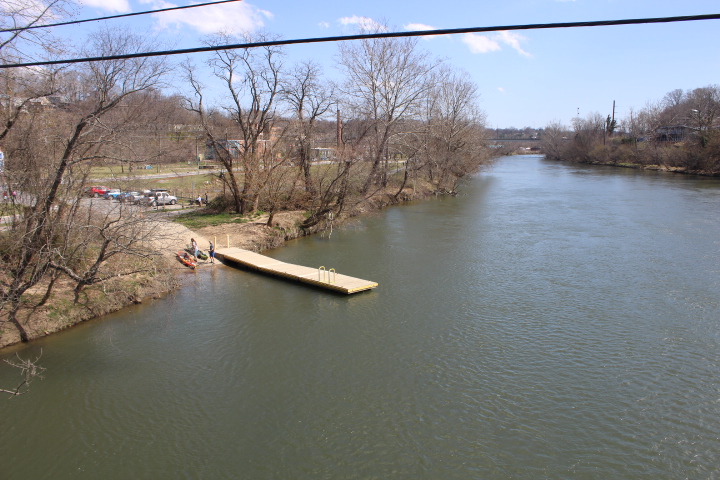As the French Broad River snakes through Asheville, it stretches past breweries and bars, art studios and coffeehouses. It’s a backdrop to bustling business, but until now, no one has tried to figure out the monetary impact of the river itself.
A recently completed study, commissioned by the French Broad River Partnership in 2019 and led by economist Steve Ha of Western Carolina University, sets the total economic value of the French Broad and its tributaries at $3.8 billion per year. By comparison, the Blue Ridge Parkway that also runs through Asheville creates about $1.3 billion in economic output per year, according to the National Park Service. (The full study is available at avl.mx/bfg.)
Throughout its eight-county watershed — Avery, Buncombe, Haywood, Henderson, Madison, Mitchell, Transylvania and Yancey — the French Broad attracts about 6.9 million visitors each year. The study estimates that each visiting group spends close to $1,300 per trip, much of that going toward food, beverages and lodging.
The most common reasons people come to the river include hiking, jogging, walking, whitewater rafting and fishing. Yet as noted by Jay Hawthorne, a member of the partnership’s steering committee and conservation chair for the Land O’ Sky Chapter of Trout Unlimited, the river’s presence has worth even when it’s not in use.
The study establishes an “existence value” of $2.4 billion for the French Broad. “It’s the willingness to pay just for having a river, even if they never use it,” Hawthorne explains. “It’s asking, if we send you a bill for this being here, would you be willing to pay? People gave us numbers — 72% said they’d be willing to pay for that alone.”
Residents were also willing to pay for the river to be protected for the use of future generations. The study sets that “bequest value” at more than $585 million.
Value judgements
Although more than 72% of individuals said they were willing to pay more to improve the river’s water quality, just 26% of surveyed businesses felt the same way. “A lot of businesses said, ‘We already pay a lot of taxes,’” Hawthorne says.
With the study in hand, he continues, the French Broad River Partnership hopes to increase public understanding about the value of the river. Through discussions with the Asheville Area Chamber of Commerce and other business leaders, the group wants to build support for addressing stormwater runoff and other water quality issues.
As one example of the river’s value, Hawthorne points to the area’s numerous craft breweries. Many local brewers use water from the French Broad River’s watershed, whether supplied from the mountain streams that flow into Asheville’s reservoirs or other tributaries throughout the river’s eight counties.
“That is why we focus on tributaries, so if they are taken care of, the main stem will be healthier,” Hawthorne says. “It all flows downstream. It’s inherently connected to everything. The river watershed encompasses almost 3,000 square miles and goes through all those different counties. You cross or drive by it every day. It’s always here — it’s always going to flow.”
In the longer term, Hawthorne says, the partnership will develop a multi-year recommendation plan to address concerns surrounding the river’s health.
Growing with the flow
Some business owners are quick to recognize the river’s financial boon. At French Broad Outfitters at 704 Riverside Drive, store manager Scott Thomas says the draw of the river, combined with the recently completed Wilma Dykeman Greenway through the River Arts District, has galvanized the whole area’s economy.
“It’s a lot more accessible for people on foot and bike,” he says. “There’s a connectedness to it; it’s more of a focus for people’s everyday activities.”
Thomas says a big part of French Broad Outfitters’ business comes from people buying tubes to take out on the river, where they can often be seen in the warmer months, floating in groups carried along by the currents.
And Rachel Wyatt, vice president of the River Arts District Artists board, says the presence of the river is connected to the work artists do in the RAD. “There’s a symbiotic relationship between the artists and the river,” she says. “We have these old industrial buildings, where artists come and do work and create. That’s a major draw for the tourists in the area. They want to see and converse with the artists, see glass blowing demonstrations and more.”
As part of that relationship, she says it’s important to protect the river from pollution. “We have to be conscious of how our actions affect things,” she says. “If the river’s polluted, that’s a bad thing. People are coming to play and watch art. So we have to respect where we are.”
Edited at 4 p.m. April 15 to accurately reflect the extent of the French Broad watershed.



I hope you folks didn’t have to pay too much for this “study”. This figure is nothing but a bunch of claptrap. 6.9 million visitors a year x $1300 per trip = voila ..$3.9 Billion! All sorts of these type “economic impact studies” are foisted on the general American public to simply justify a cause or service or business. Why don’t we cut out the “dollarization” BS and simply state the obvious; that is the French Broad is an important attribute to our region both environmentally and economically. And leave it at that.